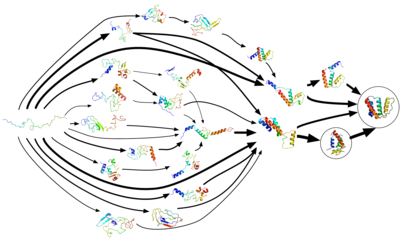Written by Jan Philipp Wöhrle, Albert-Ludwigs-Universität Freiburg
Dear fellows and friends of the Young Crystallographers,
We hope that you are all fit and healthy. I guess most of you are working in home office at the moment – that is perfect. Stay there! But while you are working you can help to fight the pandemic and in addition do a bit of biocrystallography using “Folding@home”.
“Folding@home (FAH or F@h) is a distributed computing project for performing molecular dynamics simulations of protein dynamics. Its initial focus was on protein folding but has shifted to more biomedical problems, such as Alzheimer’s disease, cancer, COVID-19, and Ebola.” [1]
“Proteins are an essential component to many biological functions and participate in virtually all processes within biological cells. They often act as enzymes, performing biochemical reactions including cell signaling, molecular transportation, and cellular regulation. As structural elements, some proteins act as a type of skeleton for cells, and as antibodies, while other proteins participate in the immune system. Before a protein can take on these roles, it must fold into a functional three-dimensional structure, a process that often occurs spontaneously and is dependent on interactions within its amino acid sequence and interactions of the amino acids with their surroundings. Protein folding is driven by the search to find the most energetically favorable conformation of the protein, i.e., its native state. Thus, understanding protein folding is critical to understanding what a protein does and how it works, and is considered a holy grail of computational biology.” [2, 3]

The organization is currently using its resources to combat the coronavirus pandemic and you can help to solve the problem – just follow the link: https://foldingathome.org/
If you need more information about the project visit: https://foldingathome.org/2020/03/15/coronavirus-what-were-doing-and-how-you-can-help-in-simple-terms/
Stay at home, stay healthy and – if you like – start folding ;)
References:
- [1] Wikipedia/Folding@home, https://en.wikipedia.org/wiki/Folding@home, checked 03/24/20.
- [2] Fabrizio Marinelli, Fabio Pietrucci, Alessandro Laio, Stefano Piana (2009). Pande, Vijay S. (ed.). „A Kinetic Model of Trp-Cage Folding from Multiple Biased Molecular Dynamics Simulations“. PLOS Computational Biology. 5 (8): e1000452. Bibcode:2009PLSCB…5E0452M. doi:10.1371/journal.pcbi.1000452. PMC 2711228. PMID 19662155.
- [3] „So Much More to Know“. Science. 309 (5731): 78–102. 2005. doi:10.1126/science.309.5731.78b. PMID 15994524.
- [4] Pande lab. „Client Statistics by OS“. foldingathome.org. Retrieved March 13, 2020.
- [5] Bowman, Greg (March 20, 2020). „Amazing! @foldingathome now has over 470&nbso;petaFLOPS of compute power. To put that in perspective, that’s more than 2x the peak performance of the Summit super computer!“. @drGregBowman. Retrieved March 20, 2020.